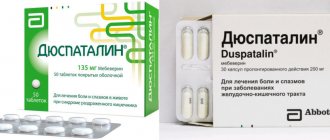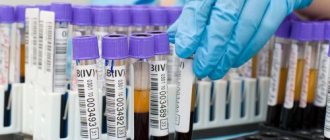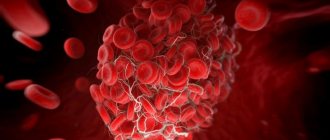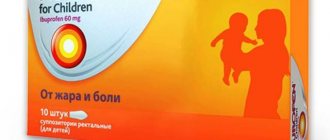Properties of platelets
Platelets, blood cells, are produced in the bone marrow, live a little more than a week, and break down in the spleen (most of them) and in the liver. They have a round shape and look like lenses. The larger the platelet, the younger it is. Scientists have long noticed under a microscope that with any action of irritants they swell, release villous processes, and adhere to each other.
The main tasks of platelets in the body:
- protection against bleeding - cells stick together to form blood clots that block the wounded vessel;
- synthesis of growth factors that influence tissue repair processes (epithelium of the membranes of various organs, endothelium of the vascular wall, bone fibroblast cells).
The platelet level fluctuates: it decreases at night, in the spring, in women during menstruation, and pregnancy. Lack of vitamin B12 and folic acid in foods is known to reduce platelet counts. Such fluctuations are temporary, physiological in nature.
The normal level of blood platelets is considered to be 150 thousand in one microliter (150 x109/l). Amounts below this figure are classified as thrombocytopenia, a pathological condition.
Development mechanism
It is not immediately possible to say exactly what is causing the pathological process. It takes a lot of time for a thorough diagnosis.
Despite the difficulties in determining the etiology, the pathogenetic features and patterns are always approximately the same.
Thrombocytopenia is associated with an insufficient concentration of formed blood cells during their normal functional activity. Platelets, which are precisely involved in the formation of the pathological process “in the first place,” act as a kind of adhesive filler material.
Any injury, wound, damage associated with a violation of the integrity of the skin and not only goes through several stages.
Bleeding stops on its own as a result of the coagulation of liquid tissue, which is impossible without the work of platelets. This is the key role of these cells.
The mechanism of development of the disorder is based on a group of possible causes. Generally speaking, this is:
- Congenital features of platelet production. Many diseases and syndromes that exist in patients from the moment of birth provoke disorders of the hematopoietic system.
Such pathologies are dangerous in themselves, and when combined with thrombocytopenia they become an even greater threat. There is a system failure that causes fundamental deviations that are not amenable to qualitative radical correction.
- Violation of the biochemical component of the synthesis or aggregation of formed cells is the most common cause of thrombocytopenia. It is difficult to say exactly what caused the problem without diagnostics, and sometimes even after examinations a lot of questions remain.
Usually the problem is a decrease in the synthesis of so-called coagulation factors, special substances that ensure the aggregation of formed cells, their “sticking together.”
There are many specific diseases that cause such changes: from cancerous tumors of the lymphatic system, bone marrow metastases to infectious pathologies.
- Impossibility of normal clotting as a result of the inflammatory process. Autoimmune diagnoses also often provoke thrombocytopenia.
Regardless of the cause, the pathological process follows an identical scenario.
Since there are not enough platelets, those cells that exist cannot replace them and ensure complete coagulation at the right time.
This leads to a transformation of the rheological properties of blood, its dilution. The permeability of small vessels increases.
Complications are deadly due to their intensity. We're talking about bleeding. In the early stages - external, subcutaneous, small hematomas, bruises. In later cases - lethal internal, spontaneous, for no apparent reason.
Determining the mechanism is necessary to understand the ways of proper treatment, rid the patient of such a problem and improve prospects.
Classification
Thrombocytopenia is usually classified based on a number of signs: causes, nature of the syndrome, pathogenetic factor, severity of hemorrhagic manifestations. According to the etiological criterion, primary (idiopathic) and secondary (acquired) thrombocytopenia are distinguished. In the first case, the syndrome is an independent disease; in the second, it develops secondarily, with a number of other pathological processes.
Thrombocytopenia can have an acute course (lasting up to 6 months, with a sudden onset and a rapid decrease in platelet count) and chronic (lasting more than 6 months, with a gradual increase in symptoms and a decrease in platelet levels).
Taking into account the leading pathogenetic factor, the following are distinguished:
- thrombocytopenia dilution
- thrombocytopenia distribution
- thrombocytopenia consumption
- thrombocytopenia caused by insufficient platelet production
- thrombocytopenia caused by increased destruction of platelets: non-immune and immune (alloimmune, autoimmune, transimmune, heteroimmune)
The criterion for the severity of thrombocytopenia is the level of blood platelets and the degree of hemostatic impairment:
- I – platelet count 150-50x109/l – hemostasis is satisfactory
- II – platelet count 50-20 x109/l – with minor trauma, intradermal hemorrhages, petechiae, and prolonged bleeding from wounds occur
- III – platelet count 20x109/l and below – spontaneous internal bleeding develops.
Classification of the disease
Like most medical diseases, thrombocytopenia has its own classification, which is formed on the basis of pathogenetic factors, causes, symptoms and various manifestations.
According to the criterion of etiology, two types of disease are distinguished:
- primary;
- secondary.
They are characterized by the fact that the primary type manifests itself as an independent illness, and the secondary type is provoked by a number of other diseases or pathological abnormalities.
According to the duration of the disease in the human body, there are two types of malaise: acute and chronic. Acute - characterized by a short duration of impact on the body (up to six months), but manifested by immediate symptoms. The chronic form is characterized by a prolonged decrease in platelets in the blood (over six months). It is the chronic type that is more dangerous, since treatment takes up to two years.
According to the criteria for the severity of the disease, characterized by the quantitative composition of platelets in the blood, three degrees are distinguished:
- I - composition is 150–50x109/l - the severity criterion is satisfactory;
- II - 50–20x109/l - reduced composition, which manifests itself with minor damage to the skin;
- III - 20x109/l - characterized by the appearance of internal bleeding in the body.
The norm of blood cells in the body is from 140,000 to 440,000/μl. But it is in the female body that these indicators are constantly changing. The changes are influenced by the following factors:
- menstruation;
- pregnancy;
- complications after pregnancy.
Classification of thrombocytopenia depending on etiopathogenetic factors
Platelets appear in the body from the bone marrow, which synthesizes blood cells by stimulating megakaryocytes. The synthesized blood plates circulate through the blood for seven days, after which the process of their stimulation is repeated.
According to the International Classification of Diseases of the Tenth Convocation (ICD-10), this disease has its own codes:
- D50-D89 - diseases of the circulatory system and other types of insufficiency.
- D65-D69 - blood clotting disorders.
Reasons for the development of pathology
Often the cause of the disease is an allergic reaction of the body to various medications, resulting in drug-induced thrombocytopenia. With such ailment, the body produces antibodies directed against the drug. Medicines that affect the occurrence of blood cell insufficiency include sedatives, alkaloids and antibacterial agents.
The causes of deficiency may also be problems with the immune system caused by the consequences of blood transfusions.
The disease manifests itself especially often when blood groups do not match. Autoimmune thrombocytopenia is most often observed in the human body. In this case, the immune system is unable to recognize its platelets and rejects them from the body. As a result of rejection, antibodies are produced to remove foreign cells. The causes of such thrombocytopenia are:
- Pathological kidney failure and chronic hepatitis.
- Lupus, dermatomyositis and scleroderma.
- Leukemic diseases.
If the disease has a pronounced form of an isolated disease, then it is called idiopathic thrombocytopenia or Werlhof’s disease (ICD-10 code: D69.3). The etiology of idiopathic thrombocytopenic purpura (ICD-10:D63.6) remains unclear, but medical scientists are inclined to believe that the cause is a hereditary predisposition.
The manifestation of the disease is also typical in the presence of congenital immunodeficiency. Such people are most susceptible to the factors causing the disease, and the reasons for this are:
- damage to the red bone marrow from exposure to drugs;
- immunodeficiency leads to damage to megakaryocytes.
There is a productive nature of the disease, which is caused by insufficient production of platelets by the bone marrow. In this case, their insufficiency occurs, which ultimately develops into malaise. The causes are considered to be myelosclerosis, metastases, anemia, etc.
A lack of platelets in the body is observed in people with a reduced composition of vitamin B12 and folic acid. Excessive radioactive or radiation exposure to cause blood cell deficiency cannot be ruled out.
Thus, two types of causes influencing the occurrence of thrombocytopenia can be distinguished:
- Leading to the destruction of blood cells: idiopathic thrombocytopenic purpura, autoimmune disorders, cardiac surgery, clinical circulatory disorders in pregnant women and side effects of drugs.
- Contributing to a decrease in the production of antibodies by the bone marrow: viral influences, metastatic manifestations, chemotherapy and radiation, as well as excessive alcohol consumption.
Causes of primary thrombocytopenia
The causes of insufficient platelet levels in the blood are divided into 3 groups.
Factors causing increased cell destruction when:
- various autoimmune processes (rheumatoid polyarthritis, systemic lupus);
- blood diseases (thrombocytopenic purpura);
- taking medications (sulfonamides, heparin, antiepileptic drugs, some medications for the treatment of cardiovascular and gastrointestinal diseases);
- during preeclampsia in pregnant women;
- after heart bypass surgery.
Factors that interfere with platelet reproduction when:
- radiation therapy;
- blood cancer (leukemia);
- infectious diseases (AIDS, hepatitis C, chicken pox, mononucleosis, rubella);
- tumor chemotherapy;
- long-term use of alcohol;
- deficiency of vitamin B12 and folic acid in food.
Other reasons:
- pregnancy (thrombocytopenia in pregnant women is described in detail here);
- large volume of blood transfusion;
- enlarged spleen (splenomegaly) due to various liver diseases, infections, has the ability to capture and destroy platelets;
- thrombocytopenia in a newborn child is rare and is explained by a delay in the development of hematopoiesis due to infectious diseases suffered by the mother;
- hereditary causes are observed when thrombocytopenia is combined with bleached areas of hair, impaired pigmentation of the skin, retina, eczema, and a tendency to infections.
Thrombocytopenic purpura with skin manifestations
Symptoms of thrombocytopenia
Regardless of the cause of thrombocytopenia in adults, a decrease in the number of blood platelets in the blood is manifested by the following symptoms:
- Multiple subcutaneous hemorrhages are found on the human body, which can be presented both in the form of small dots and in the form of large hematomas. Moreover, they are formed even with a minor impact or other physical impact.
- The rash may be blue, brown, green or yellowish in color. This indicates that they did not appear at the same time, but at different times (some are passing, others are completely fresh).
- Hemorrhages often also occur in the eyeball.
- Bleeding of internal organs, including the brain, may develop.
- Sometimes a symptom of thrombocytopenia is an increase in the size of the spleen.
- Hemorrhages are located on the arms and legs, on the abdomen, on the face, in the mouth, and on the chest.
- A person notices increased bleeding of the gums and is bothered by nosebleeds, which happen quite often.
- Women experience prolonged menstruation, and bleeding from the vagina also occurs in between cycles.
- Against the background of thrombocytopenia, bleeding after operations poses a danger to human life. Moreover, it is not necessary that the intervention will be global. We are even talking about removing teeth or overgrown tonsil tissue.
Symptoms of thrombocytopenia are explained not only by the fact that the blood loses its ability to clot, but also by the fact that the permeability of the vascular wall increases. Blood cannot clot due to the fact that the production of the enzyme that is responsible for gluing platelets to the vascular wall, as well as for their normal size, is impaired. Vessels lose normal permeability due to the fact that their nutritional processes, for which platelets are responsible, are disrupted. The effect is exerted by low levels of serotonin, which is also produced by platelets and regulates normal contractions of the vascular wall.
Symptoms of the disease
Symptoms of thrombocytopenia disease have different types of manifestations. It depends:
- firstly, from the cause of occurrence;
- secondly, on the nature of the disease (chronic or acute).
The main signs of damage to the body are manifestations on the skin in the form of hemorrhages and bleeding. Hemorrhages are most often observed on the limbs and torso. Damage to a person’s face and lips is possible. To illustrate the manifestation of hemorrhages on the human body, the photo below is presented.
Symptoms of thrombocytopenia
Thrombocytopenia is characterized by symptoms of prolonged hemorrhages after tooth extraction. Moreover, the duration of hemorrhage can be one day or be accompanied for several days. It depends on the extent of the disease.
With symptoms, there is no increase in the size of the liver, but very often doctors observe an enlargement of the lymph nodes of the cervical region. This phenomenon is often accompanied by an increase in body temperature to subfebrile levels (from 37.1 to 38 degrees). An increase in the rate of red blood cell accumulation in the body is evidence of the presence of a disease called lupus erythematosus.
Symptoms of platelet deficiency are quite easily observed after taking blood for analysis. The quantitative composition will differ significantly from the maximum standards. When the number of platelets in the blood decreases, their size increases. This is reflected on the skin as the appearance of red and bluish spots, which indicates the transformation of blood cells. There is also destruction of red blood cells, which leads to a decrease in the quantitative composition, but at the same time the number of reticulocytes increases. There is a phenomenon of a shift in the leukocyte formula to the left.
The human body with a reduced composition of blood cells is characterized by an increase in the composition of megakaryocytes, which is caused by frequent and extensive bleeding. The duration of blood clotting is noticeably increased, and the reduction in clotting of blood released from the wound is reduced.
According to the symptoms of the disease, there are three degrees of complications: mild, moderate and severe.
Mild degrees are typical causes of the disease in women with prolonged and heavy menstruation, as well as with intradermal bleeding and nasal hemorrhages. But at the mild stage, diagnosing the disease is extremely difficult, so the presence of the disease can be confirmed only after a detailed medical examination.
The average degree is characterized by the appearance of a hemorrhagic rash throughout the body, which consists of numerous pinpoint hemorrhages under the skin and on the mucous membrane.
Severe grades are characterized by gastrointestinal disorders caused by hemorrhages. The platelet count in the blood is up to 25x109/l.
Symptoms of secondary thrombocytopenia have similar features.
Pregnancy and illness: symptoms
Types of thrombocytopenia during pregnancy
Thrombocytopenia in pregnant women is characterized by significant changes in the quantitative composition of cells in the blood of women. If there is no diagnosis of the disease in pregnant women, but the platelet composition indicator decreases slightly, this indicates that their vital activity is decreasing and their participation in the periphery of the blood circulation is increasing.
If there is a reduced composition of platelets in the blood of a pregnant woman, then these are direct prerequisites for the development of the disease. The reasons for the reduced number of platelets are the high rates of death of these bodies and low rates of formation of new ones. Clinical signs are characterized by subcutaneous hemorrhages. The causes of insufficiency of colorless cells are incorrect composition and nutritional standards or a small amount of food consumption, as well as damage to the immune system and various blood losses. Through this corpuscle are produced by the bone marrow in small quantities or have an irregular shape.
Thrombocytopenia during pregnancy is very dangerous, so the issue of diagnosis, and especially treatment, is given maximum attention. The danger is that a lack of platelets in the mother's blood during pregnancy contributes to the occurrence of hemorrhage in the child. The most dangerous hemorrhage in the womb is cerebral, the result of which is characterized by fatal consequences for the fetus. At the first sign of such a factor, the doctor makes a decision about premature birth in order to eliminate the consequences.
Childhood thrombocytopenia: symptoms
Pediatric thrombocytopenia
Thrombocytopenia in children is quite rare. The risk group includes school-age children, whose incidence is more common in winter and spring.
Thrombocytopenia and its symptoms in children are practically no different from adults, but it is important for parents to diagnose it based on the first signs in the early stages of development of the disease. Children's symptoms include frequent bleeding from the nasal cavity and the appearance of small rashes on the body. Initially, the rash appears on the lower extremities of the body, and then they can be observed on the arms. With minor bruises, swelling and hematomas occur. Such signs most often do not cause concern to parents, due to the absence of pain symptoms. This is an important mistake, because any disease in its advanced form is dangerous.
Bleeding gums indicate a lack of platelets in the blood in both children and adults. In this case, feces in a sick person, and more often in children, are excreted together with blood clots. Hemorrhage due to urination cannot be ruled out.
Depending on the degree of impact of the disease on the immune system, a distinction is made between immune and non-immune platelet deficiency. Immune thrombocytopenia is caused by massive death of blood cells under the influence of antibodies. In such a situation, the immune system’s own blood cells are not recognized and are rejected from the body. Non-immune disease manifests itself through physical impact on blood platelets.
Thrombocytopenia during pregnancy
It has been noticed that the number of platelets during pregnancy changes unevenly, because the individual state of the woman’s body is of great importance here. If the pregnant woman is healthy, there may be a slight decrease in platelets. This is explained by a decrease in their life span and their increased participation in the process of peripheral circulation.
When platelet counts are low, there are prerequisites for the development of thrombocytopenia. The reason for this is a decrease in the formation of blood platelets, a high degree of their death or consumption. Clinically, the disease is expressed by bleeding and subcutaneous hemorrhages. Factors of platelet deficiency include insufficient nutrition of a pregnant woman, disorders of immune etiology, or chronic blood loss. Thus, platelets are not produced or become abnormally shaped.
To diagnose thrombocytopenia, a blood clotting test is performed in the form of a coagulogram. This is a very informative and accurate method. The importance of obtaining information on the content of platelets in the blood is that it makes it possible to avoid serious complications during childbirth. So, in a baby with thrombocytopenia of an immune nature, during childbirth there is a high development of internal bleeding, the most dangerous of which is cerebral hemorrhage. In this scenario, the attending physician decides on surgical delivery. In most cases, this disease does not threaten the health of the baby.
Symptoms
Let's look at the symptoms in more detail.
- After tooth extraction, unstoppable bleeding. During the elimination of a tooth, the artery and capillaries in the gum rupture. Normally, bleeding stops within 5-20 minutes. Therefore, if there are problems with the content of platelets in the blood, it will continue for a long time.
- Hemorrhage into the skin and mucous membranes. This symptom is the most specific and is considered the main one. The patient develops small red spots, especially in places where clothing presses. They arise due to the fact that the skin and mucous membranes are saturated with blood. There is no pain, the spots do not disappear if you press on them. There are petechiae and ecchymoses. The former are single hemorrhages, and the latter are large spots. There may also be red and blue streaks that turn green and yellow over time.
- Long and heavy periods. Typically, women's periods last from three to five days. In this case, the volume of discharge is no more than 150 ml, including the layer of the rejected surface. Of this amount, blood takes up from 50 to 80 ml. If thrombocytopenia is observed, then menstruation becomes more abundant.
- Constant nosebleeds. The nasal mucosa has a large number of capillaries. As the concentration of platelets decreases, they become brittle. Provoking factors include sneezing, colds, microtrauma, and foreign bodies. The blood will be bright red. Bleeding with idiopathic thrombocytopenia can last several tens of minutes, so the person may even lose consciousness.
- Blood in urine. This symptom has its own name - hematuria. It manifests itself when a person has a hemorrhage in the bladder. Urine can have different colors, depending on the amount of blood. Sometimes its content is so small that it can only be detected during laboratory research.
- Gum problems. Some patients may experience bleeding when brushing their teeth. It's quite difficult to stop him.
- Bleeding in the gastrointestinal tract. This symptom occurs due to fragility of blood vessels and when eating heavy, tough foods. Blood may leave the body through stool (colored red) or through vomiting. The last symptom indicates that a person has bleeding in the gastric mucosa. Sometimes this can cost a person his life.
Additional symptoms may include those that are specific to the disease that caused the platelet problem.
Diagnostics
The very first method for detecting thrombocytopenia is a clinical blood test. A deficiency of cells is detected in it, and the maturity of the remaining elements is assessed. This is important for determining the cause of the disease. If a violation of the formation and maturation of blood platelets is suspected, a bone marrow puncture is prescribed.
In order to exclude a deficiency of coagulation factors, a coagulogram is examined, and if there are signs of an autoimmune nature of the disease, antibodies to platelets are determined. In addition to these methods, ultrasound of the liver and spleen, chest x-ray, and immunological blood tests are recommended.
Treatment methods
Inpatient therapy. The acute period is stopped in the hospital. The basis is the use of certain medications:
- Hormonal agents. Prednisolone and others.
- Intravenous infusions of immunoglobulin.
- Injection of platelets from outside. Artificially increasing their concentration in the riverbed.
- Plasmapheresis. Purification of the liquid fraction of blood if necessary.
- Autoimmune thrombocytopenia requires the use of cytostatics to reduce the intensity of the reaction of one's own protective bodies. The names are selected by the doctor; there are a lot of them.
If ineffective, the spleen is removed - splenectomy. As practice shows, the result is achieved in almost 70% of cases, subject to complex treatment.
Attention:
You should not take drugs based on acetylsalicylic acid, antiplatelet agents and anticoagulants, non-steroidal anti-inflammatory drugs and thrombolytics.
Treatment of thrombocytopenia involves long-term use of pharmaceuticals with constant dose adjustment under the supervision of a hematologist.
Treatment of thrombocytopenia
Treatment of symptomatic thrombocytopenia associated with other diseases requires primary therapy for the underlying disease.
Acute forms
Thrombocytopenia in the acute period should be treated in a hospital, where the patient is hospitalized. Strict bed rest is prescribed until the physiological level (150 thousand per μl) of platelets is reached.
At the first stage of treatment, the patient is prescribed corticosteroid drugs, which he takes for up to 3 months; removal of the spleen, if there is no choice, is planned at the second stage and the third stage of treatment is provided for patients after splenectomy. It consists of the use of small doses of prednisolone and therapeutic plasmapheresis.
As a rule, intravenous infusions of donor platelets are avoided, especially in cases of immune thrombocytopenia due to the risk of aggravating the process.
Platelet transfusions provide a remarkable therapeutic effect if they are specially selected (specifically for this patient) according to the HLA system, however, this procedure is very labor-intensive and inaccessible, therefore, with deep anemia, it is preferable to transfuse thawed, washed red blood cells.
It should be remembered that drugs that disrupt the aggregation abilities of blood cells (aspirin, caffeine, barbiturates, etc.) are prohibited for a patient with thrombocytopenia, which, as a rule, the doctor warns him about upon discharge from the hospital.
Further treatment
Patients with thrombocytopenia require further monitoring by a hematologist and after discharge from the hospital. A patient who needs sanitation of all foci of infection and deworming is given them, he is informed that ARVI and exacerbation of concomitant diseases provoke a corresponding platelet reaction, therefore hardening and physical therapy, although they should be mandatory, are introduced gradually and carefully.
In addition, the patient is required to keep a food diary, where nutrition for thrombocytopenia is carefully described. Injuries, overloads, and uncontrolled intake of seemingly harmless medications and foods can trigger a relapse of the disease, although the prognosis for it is usually favorable.
The diet for thrombocytopenia is aimed at eliminating allergenic foods and saturating the diet with B vitamins (B12), folic acid, and vitamin K, which takes part in the blood clotting process.
Advice for patients with thrombocytopenia
- People suffering from thrombocytopenia should remember the need to consult a doctor in case of any injury, even harmless at first glance. It’s even better if the sick person avoids injuries.
- It would probably not be out of place to say that these people should avoid enemas, and generally reduce rectal examinations to a minimum, and they should not perform intramuscular injections. And for intravenous injections, the injection site of the needle should be pressed (within reason) for 10-12 minutes.
- In general, these people need to treat themselves, as it would be better and more accurate to say, with love and attention. Before purchasing a toothbrush, you should ask whether its bristles are too hard. And exclude straight razors and dental floss from “your diet” altogether.
And yet, patients with thrombocytopenia should not use drugs that suppress platelet function. For example, non-steroidal anti-inflammatory drugs - the same Acetylsalicylic acid and all its derivatives, pyrazolidinedione derivatives: Butadione, Pirabutol, Reopirin; derivatives of phenylpropionic, phenylacetic, indoleacetic and anthranilic acids: Ibuprofen, Ortofen, Indomethacin, Naproxen, Piroxicam, etc.
Diet and nutrition rules
A specific diet for patients with a history of thrombocytopenia includes a group of products containing components involved in building the supporting structure of blood cells, in the division and formation of blood cells. It is very important to avoid substances that inhibit the degree of influence at the stage of hematopoiesis.
The diet should be rich in protein, mostly of plant nature, cyanocobalamine, or vitamin B 12, and products must also contain folic and ascorbic acids. The reason for this is that with this pathology, purine metabolism is disrupted. This leads to a reduction in the consumption of animal products. Protein is replenished with plant foods containing soy: beans, peas and others. Nutrition for thrombocytopenia should be dietary and include a variety of vegetables, fruits, berries and herbs. Animal fats should be limited and it is better to replace them with sunflower, olive or some other type of oil.
An approximate list of dishes included in the menu for patients with thrombocytopenia:
- chicken broth, leading to increased appetite;
- bakery products made from rye or wheat flour;
- the first course should be soup;
- salads in vegetable oil with herbs;
- fish dishes from low-fat varieties of fish;
- meat products from poultry meat subjected to various heat treatments;
- side dishes are prepared from cereals, pasta;
- There are no restrictions on drinks.
In order for therapeutic nutrition to be beneficial and help in the treatment of thrombocytopenia, it is important to follow some rules. First, thiamine and nitrogen-containing foods are needed to control the release of new blood cells from the spleen. Secondly, the supporting structure of blood cells requires a sufficient supply of lysine, methionine, tryptophan, tyrosine, lecithin and choline, which belong to the group of essential amino acids. Third, the separation of blood cells is impossible without microelements such as cobalt, B vitamins, and substances containing ascorbic and folic acid. And fourth, the quality of hematopoiesis depends on the presence of lead, aluminum, selenium and gold in the blood. They have a toxic effect on the body.
Thrombocytopenia - what is it? Causes and treatment of the disease, Ask the Doctor
Thrombocytopenia - what is it, is the disease curable and why is a change in blood composition considered a pathology?
Thrombocytopenia is a condition with a characteristic decrease in the quantitative indicators of platelets below 150x10 in 9 g/l circulating in the peripheral blood. This leads to increased bleeding, the risk of internal bleeding and poor blood clotting when blood vessels are injured. The article was checked by doctor Victoria Druzhikina
Neurologist, Therapist
The disease is known to hematologists both as an independent blood disease and as a sign of other serious pathologies.
Primary thrombocytopenia depends on changes in the process of hematopoiesis and the production of antibodies to one’s own platelets. Secondary is a pathology resulting from other diseases, radiation exposure, severe toxic poisoning, and alcoholism.
ICD10 code for primary thrombocytopenia is D69.1, secondary thrombocytopenia is D69.5
The causes of the disease depend on the pathological processes occurring in the body:
- Platelet deficiency in the bone marrow. It is observed in aplastic and megablastic anemia, metastasis of malignant tumors into the body of the red brain, acute and chronic leukemia, and viral invasion. It can be a consequence of taking medications and a course of radiation therapy.
- Massive bleeding or increased platelet destruction.
- Impaired distribution of platelets or their excessive deposition.
- Excessive rate of destruction of blood plaques and attenuation of compensatory mechanisms.
- Anomalies in the development of the skeletal system.
The mechanics of the development of the disease are identical for all cases - the concentration of platelets decreases, which provokes disturbances in the nutrition of the capillary walls, and this leads to their excessive fragility.
The result is spontaneous or traumatic bleeding due to rupture of small vessels. Since the platelet count is low, a platelet plug does not appear inside the damaged vessel, and this causes a massive release of blood outside the vessel into the surrounding tissue.
The greatest danger for the patient is the fact that a decrease in platelets to 100x10 in 9 g/l is asymptomatic (at a normal level of 180-320x10 in 9 g/l). A person feels quite comfortable, but at the same time life-threatening conditions, for example, anemia, are already developing in his body.
The prognosis for the outcome of the disease is determined by several factors:
- severity of clinical symptoms and duration of the disease;
- presence of complications;
- timeliness and correctness of treatment;
- the severity of the underlying disease.
All patients undergoing treatment for thrombocytopenia should undergo a complete blood count every 6 months for preventive purposes.
Thrombocytopenia is insidious with sudden relapses. Against the background of complete well-being, a sharp drop in platelets is possible. This is mainly characteristic of thrombocytopenia in blood diseases.
Such patients, in addition to laboratory monitoring, require self-monitoring. Even slight bleeding of the gums should alert you.
In this case, you do not need to undergo a scheduled examination; you must immediately make an appointment.
Depending on the causes of development, thrombocytopenia is divided into several types.
A group of diseases caused by a genetic mutation:
- May–Hegglin anomaly;
- congenital amegakaryocytic thrombocytopenia;
- Wiskott–Aldrich syndrome;
- TAR – syndrome;
- Bernard–Soulier syndrome.
A group of diseases of the hematopoietic organs with a characteristic change in the process of platelet production by red bone marrow:
- acute leukemia;
- aplastic anemia;
- myelofibrosis;
- myelodysplastic syndrome;
- megaloblastic anemia.
Also, a productive form of the disease can develop as a result of metastasis of a cancerous tumor (the diagnosis is made and treated by an oncologist), the use of cytostatic drugs, hypersensitivity to medications, exposure to radiation, and alcohol abuse.
Leads to increased destruction of platelets in the spleen, sometimes in the liver or lymph nodes:
- idiopathic thrombocytopenic purpura;
- post-transfusion thrombocytopenia;
- thrombocytopenia of newborns;
- Evans–Fisher syndrome;
- drug and viral thrombocytopenia.
Platelets are activated in the vascular bed, which triggers the blood coagulation mechanism, which has a pronounced symptomatic character. The greater the consumption of platelets, the more the body tends to produce them.
If the cause of activation is not eliminated, the compensatory capabilities of the red brain will be exhausted:
- hemolytic-uremic syndrome;
- thrombotic thrombocytopenic purpura;
- disseminated intravascular coagulation syndrome;
It develops as a consequence of massive bleeding, during which the patient was transfused with a large volume of fluid, plasma substitute, plasma or red blood cells. However, the moment of need to compensate for platelet loss was missed.
Their concentration in the blood decreases so much that the emergency release of platelets from the depot does not help maintain adequate functioning of the coagulation system.
A consequence of impaired platelet deposition due to splenomegaly. 90% of platelets settle in the spleen, which literally “confuses the body.” Regulatory systems take into account their total amount, and not the amount that circulates in the blood.
Doctor's advice
Many people wonder whether thrombocytopenia is curable. It depends on the reason. If it is an infection, then when it is cured, all symptoms go away. In case of liver pathologies, complete relief from thrombocytopenia is also possible.
If it’s leukemia, then when the condition stabilizes, the platelet count increases, but there will be concern about a relapse. In the case of congenital genetic abnormalities, the disease cannot go away because the body does not work correctly.
But there is always supportive therapy that allows you to maintain a decent standard of living.
A large percentage of deposition by the spleen leads to a compensatory increase in their production, this happens when:
- liver cirrhosis (hepatologist treats and consults);
- systemic lupus erythematosus;
- alcoholism;
- lymphoma or leukemia;
- infectious invasion: malaria, hepatitis, tuberculosis, etc.
In a child, the pathology is expressed in a typical symptomatic complex, complicated by hemorrhagic syndrome. It develops against the background of a decrease in the number of platelets, due to their rapid destruction or insufficient production.
An increased rate of platelet destruction is a consequence of:
- immunopathological processes leading to heteroimmune, transimmune and isoimmune thrombocytopenia;
- vasopathy, Kasabach-Merritt syndrome, systemic inflammatory response syndrome, respiratory system disorder syndrome, aspiration syndrome, pneumonia, pulmonary hypertension, infectious invasions, disseminated intravascular coagulation syndrome;
- thrombocytopathies of Wiskott-Aldrich, Shwachman-Diamond, May-Hegglin,
- overdose of certain drugs, hyperbilirubinemia, acidosis, generalized form of viral infections, long-term parenteral nutrition;
- isolated or generalized post-traumatic thrombosis, hereditary deficiency of antithrombin III and protein C, antiphospholipid syndrome in the mother;
- blood transfusion, hemosorption, plasmapheresis.
A common cause of decreased platelet production in children is megakaryocytic hypoplasia caused by TAR syndrome, leukemia, aplastic anemia, neuroblastoma, and trisomy.
Newborns are at risk when the rate of thrombocytopoiesis in the mother decreases, preeclamptic conditions during pregnancy, extremely low birth weight, antenatal hemolytic disease, deficiency of thrombocytopoietin production, etc.
Children's thrombocytopenia can develop against the background of severe suffocation, infection, sepsis, polycythemia, and thyrotoxicosis. A pediatrician treats diseases in children.
For infants, the pathology is dangerous due to an asymptomatic increase in the rate of platelet destruction.
Only 5-7% of total cases of childhood thrombocytopenia are associated with a quantitative decrease in platelet synthesis.
The main function of platelets is hemostasis, which means their deficiency causes bleeding of varying intensity and localization. As long as the platelet count exceeds 50,000 per microliter of blood, the clinical symptoms of the disease are weak. But the lower the number of these blood cells, the more pronounced the signs of pathology appear.
Symptoms of thrombocytopenia are the following:
- pinpoint hemorrhages in the mucous membrane or skin (thrombocytopenic purpura);
- sudden, frequent and heavy nosebleeds;
- bleeding gums (especially when brushing teeth), prolonged bleeding during tooth extraction;
- bleeding in the gastrointestinal tract;
- hematuria (blood in the urine);
- heavy and prolonged menstrual bleeding in women.
In each case, the clinical picture is accompanied by symptoms of the disease that caused thrombocytopenia.
Drug therapy is used to relieve thrombocytopenia of immune origin, with the characteristic production of antiplatelet antibodies and further destruction of platelets in the spleen. With the help of drug treatment, hemorrhagic syndrome and the immediate cause of the disease are eliminated.
Drugs used in the treatment of thrombocytopenia:
- " Prednisolone " - used to relieve secondary and immune pathologies. Stabilizes the process of antibody production and prevents the destruction of platelets.
- “Intraglobin” - allows the body to receive donor immunoglobulins and suppresses the production of antibodies.
- Vincristine is reduce the production of antibodies to platelets.
- "Revolade" - reduces the risk of bleeding, is used to treat the idiopathic form of the disease.
- " Depo-Provera " - prescribed to women with heavy menstrual bleeding due to thrombocytopenia.
- " Etamzilat " is the drug of choice for thrombocytopenia of any origin, except DIC syndrome. Helps normalize blood microcirculation and enhances thrombus formation in injuries.
- Cyanocobalamin (B12) - used for megablastic anemia, helps normalize the synthesis of platelets and red blood cells.
Hematologists consider the following as additional treatment methods:
- transfusion therapy;
- splenectomy;
- bone marrow transplant.
Treatment is prescribed by a hematologist based on data from a preliminary examination of the patient.
Thrombocytopenia has a peculiarity - two peaks of incidence: children of preschool age and adults aged 40+. If we consider the gender side of the issue, women suffer from thrombocytopenia three times more often. Children get sick quite rarely, approximately 50 episodes per million.
Source: https://sprosivracha.com/articles/health/113-trombocitopeniya-chto-eto-takoe-prichiny-simptomy-i-lechenie-zabolevaniya
Consequences and complications
The main manifestations of thrombocytopenia are hemorrhages and bleeding. Depending on their location and intensity, various complications can develop, sometimes life-threatening.
The most serious complications of thrombocytopenia are:
- Brain hemorrhage. It is a relatively rare, but the most dangerous manifestation of thrombocytopenia. It can occur spontaneously or with head injuries. The occurrence of this condition is usually preceded by other symptoms of the disease (hemorrhages in the oral mucosa and facial skin, nosebleeds). Manifestations depend on the location of the hemorrhage and the volume of blood shed. The prognosis is poor - approximately a quarter of cases are fatal.
- Retinal hemorrhage. It is one of the most dangerous manifestations of thrombocytopenia and is characterized by the saturation of the retina with blood released from damaged capillaries. The first sign of a retinal hemorrhage is a deterioration in visual acuity, after which a sensation of a spot in the eye may appear. This condition requires urgent qualified medical care, as it can lead to complete and irreversible loss of vision.
- Posthemorrhagic anemia. Most often develops with heavy bleeding in the gastrointestinal system. It is not always possible to diagnose them immediately, and due to increased capillary fragility and a reduced platelet count, bleeding can continue for several hours and often recurs (repeats). Clinically, anemia is manifested by pallor of the skin, general weakness, dizziness, and death can occur if more than 2 liters of blood are lost.
Symptoms
The clinic depends on the severity of the pathological process. Typical manifestations in adults and children are:
- Hemorrhagic rash is a characteristic symptom of thrombocytopenia. It looks like red spots, small ulcers of a deep scarlet color on the skin. This is the result of minor hemorrhages. Entire lesions are formed that are clearly visible. Typical localization is the lower extremities, abdomen, groin. Slightly less common are the hands and face.
- Bruising. Hematomas are small at first, then reach serious sizes, up to covering a quarter to a third of the limb. This is an alarming sign; it indicates the progression of the disorder.
- Bleeding gums. For no apparent reason.
- Heavy menstruation, menorrhagia. In some cases, even at stage 2, this phenomenon can become fatal.
- With frequent, albeit small, bleeding, secondary or tertiary anemia develops. Actually the result of a lack of hemoglobin with all the ensuing consequences. Weakness, dizziness, pallor, perversion of gastronomic preferences (patients often eat chalk, etc.).
- Nosebleeds.
- Immune thrombocytopenia is accompanied by damage to joints and mucous membranes, although not in all cases.
Gradually the situation becomes critical. It is not possible to perform even minimal surgical interventions. For example, removing a bad tooth.
Bleeding in such a situation persists for several hours or even days. Is it dangerous.
At the final stage, spontaneous critical disorders develop, and the patient dies from a massive effusion of liquid tissue. Internal bleeding begins for no apparent reason.
Do not forget about the manifestations of the underlying disease, which provokes a change in the concentration of formed cells.









